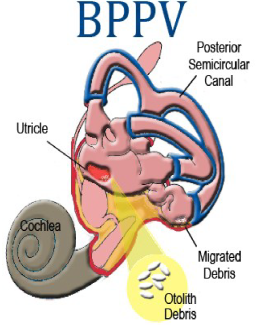
Impressive Results: Numerous trials demonstrate the efficacy of physical therapy approaches for BPPV. Noteworthy among these for the large number of patients treated and the length of follow-up is a study slated for publication in Audiology and Neurotology in 2013. Researchers followed 965 patients with confirmed BPPV (posterior, anterior, and/or horizontal canal) for up to 74 months. Symptom duration ranged from one-day to eighteen months. Eighty-five percent of cases resolved with one treatment, and 98% of cases resolved with two or three treatments. Over the course of more than six years, recurrence was only 14% , with elderly patients and patients with head trauma leading that average.
Pathophysiology & Diagnosis: BPPV is caused when otolith debris degenerates within the utricle and migrates into the semi-circular canals – predominantly the posterior canal. The material either adheres to the cupula (cupulolithiasis) or lies within the long process of the canal (canalalithiasis) and causes deflection of the cupula with changes in head position. In younger patients, other ear dysfunctions often precede BPPV. Diagnosing PC-BPPV involves identifying four classic criteria:
1. Transient rotatory-torsional nystagmus toward the undermost ear when side-leaning or lying
2. Subjective vertigo that parallels the nystagmus
3. Latency of onset of nystagmus
4. A possible reversal of nystagmus upon return to sitting position
The head re-positioning techniques work to mobilize debris in the posterior canal so that it can return to the utricle and dissolve.
Vertebral compression of the artery contraindicates some maneuvers in vestibular rehabilitation. Complications from the BPPV repositioning maneuvers include horizontal canal migration and canalith jam. Additional repositioning maneuvers can correct both of these complications.

